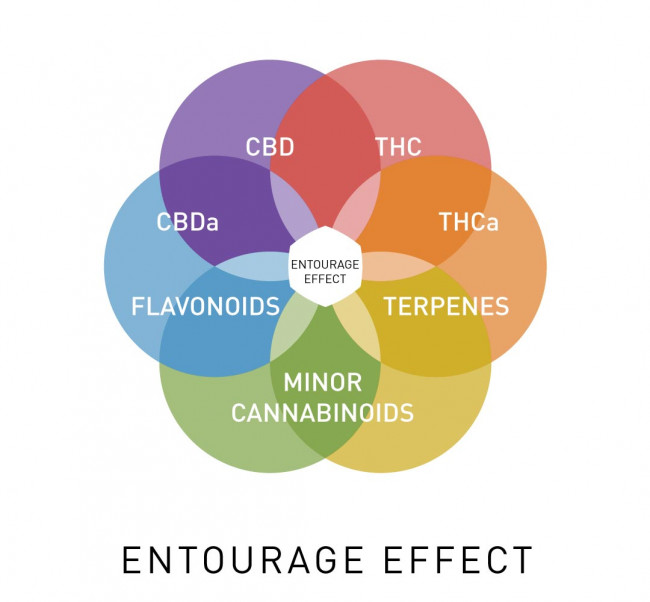The cannabis plant is rich with a variety of chemical elements including phytocannabinoids or “cannabinoids,” terpenes, and flavonoids. In fact, the plant is said to have over 400 distinct compounds. Scientists have been examining the interactions of these elements and how those interactions could produce particular effects.
In 1998, Shimon Ben-Shabat and Raphael Mechoulam coined the term, the “Entourage Effect,” as a way to describe the synergistic and antagonist way the molecules affect one another. The term was then picked up by other scientists, including Dr. Ethan Russo, and used as an easy way to explain a complex process.
If you think of the literal definition of entourage, it refers to a group of people who attend to or surround an important person such as a celebrity. Now think of what we know about cannabinoids, for example. In the past, the focus was on THC as the “celebrity” and coveted cannabinoid, the one that was most well-known to produce a mind-altering effect.

With legalization, cannabis cultivators can now look at the latest research and studies to better understand how they can improve their crops by emphasizing other cannabinoids besides THC such as a new focus on CBD. Suddenly, THC is no longer the main “rock star” of cannabis - and even less so with hemp.
With greater understanding of how major and minor cannabinoids interact - and add in some terpenes - you end up with what could be described as an “Ensemble Effect,” a term suggested by the late Dr. Lester Grinspoon, a retired associate professor of psychiatry at Harvard Medical School and former senior psychiatrist at the Massachusetts Mental Health Center in Boston, Massachusetts.
In 2016, on the Planet Green Trees Radio Show, Grinspoon referred to the “therapeutic ensemble” when he stated, “I think that the ensemble is a better idea than entourage, because the word ‘entourage’ implies one item moving in this direction – and it has company,” Dr. Grinspoon explained, “and it is [the item] that is responsible for that activity, and the others just go along. That’s entourage.”
If an entourage centers around a single “star” and all the other individuals follow along, an ensemble is a group of items that are looked at as a whole rather than individually, working “in concert” to produce an overall end result. The concept of an ensemble seems to more accurately portray the current understanding of how the compounds within cannabis work.
To understand how cannabinoids can work synergistically and antagonistically, you can look at the relationship between THC and CBD. While THC binds to CB1 receptors in your brain to produce an uplifting effect, CBD doesn’t bind to CB1. Instead, it can indirectly work “against” THC by affecting the way THC binds to CB1, in a sense blocking it or tempering the effects of the THC.
More research is needed to better understand exactly how the various major and minor cannabinoids, terpenes and flavonoids interact, however, the idea of an ensemble seems more appropriate than an entourage when it comes to describing how the chemicals inside cannabis work together.
Footnotes
- Cannabis, a complex plant: different compounds and different effects on individuals (Therapeutic Advances in Psychopharmacology)
- An entourage effect: inactive endogenous fatty acid glycerol esters enhance 2-arachidonoyl-glycerol cannabinoid activity. (European Journal of Pharmacology)
- Taming THC: potential cannabis synergy and phytocannabinoid-terpenoid entourage effects
- Planet Green Trees, Episode #290- Legend- Dr. Lester Grinspoon
- Changes in Cannabis Potency over the Last Two Decades (1995-2014) - Analysis of Current Data in the United States
- Cannabis study reveals how CBD offsets the psychiatric side-effects of THC (University of Western Ontario)
- The United Chemicals of Cannabis: Beneficial Effects of Cannabis Phytochemicals on the Brain and Cognition (Recent Advances in Cannabinoid Research)